
Whether you serve quiche as a main course or as an appetizer, cooling it to the right temperature makes it taste just right and keeps your mouth from burning. The cooling time will vary depending on the size of the quiche and on the number of ingredients in the filling. Fill your quiche with the traditional bacon and Gruyere cheese of a quiche Lorraine, named for the area of France where the dish originated, or get creative with other ingredients.
Advantages of Cooling
Serving foods icy cold or piping hot affects their flavor. In the first case, your perception of the food's taste is limited because there will be no aroma and the proteins in your taste buds won't function as well as they normally do. With a piping hot quiche, your taste buds will be burned before they can taste anything. Cooling a quiche to room temperature, about 70 degrees Fahrenheit, will make it taste better.
Cooling
Small quiches and those with only one or two ingredients added to the egg custard will take 20 to 30 minutes to cool to room temperature, while large quiches with lots of fillings may take as long as one hour. Let very small appetizer quiche bites cool for only 5 to 10 minutes. Place the quiche on a wire rack while cooling to allow air to circulate under the pan.
Cooling in the Fridge
While you would never want to put a large pot of hot liquid in your refrigerator to cool off because it wouldn't cool quickly enough to keep bacteria from growing, you can speed the cooling process for quiche by placing it in the refrigerator without damaging the fridge at all. The cooler air in the refrigerator makes the quiche give up its heat more rapidly -- an illustration of Newton's Law of Cooling.
Safety
Even when cooling a very large, deep-dish quiche with lots of ingredients, you should serve it within 1-1/12-hours. Food left at room temperature after preparation for more than two hours increases your chances of getting sick from dangerous bacteria such as salmonella. To speed the cooling of a large quiche, precut the quiche into serving size portions in the pan so the heat will dissipate more quickly than it it were left intact.
Related Articles
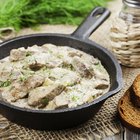
Proper Ways to Cool Food After Cooking

How Long Can Quiche Be Left ...

What Are the Best Containers to Freeze ...
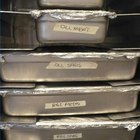
Catering Tips for Delivering Food

The Difference Between a Chafing Dish & ...
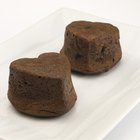
What Is a Souffle Dish?

How Long Do You Cool Muffins Before ...

How Long Is Leftover Spaghetti Good to ...

Potluck Main Dishes That Do Not Need ...
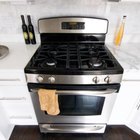
Bagel Bites Heating Instructions

Number of Times Food Can Be Reheated
Can I Make Quiche Ahead of Time?

Do I Cook Frozen Broccoli Before Baking ...

Are Nickel Lined Pans Safe?

How to Keep Ham Slices Warm for ...

How to Organize A Potluck Barbeque
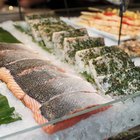
FDA Food Storage Temperature Guidelines

How Long Can Chinese Food Sit Out ...
How to Freeze Chicken Pot Pie
How Long Can Leftovers Be Refrigerated?
References
- The Deluxe Food Lover's Companion; Sharon Tyler Herbst and Ron Herbst
- The Science of Good Cooking' Editors at America's Test Kitchen and Guy Crosby
- Woman's Day: 7 Things You Didn’t Know About Your Taste Buds
- Clemson Cooperative Extension: Food Safety Mistakes You Do Not Want to Make
- U.S. Food and Drug Administration: Refrigerator Thermometers: Cold Facts about Food Safety
- What Einstein Told His Cook 2; Robert L. Wolke
- Clemson Cooperative Extension: Safe Handling of Eggs
Writer Bio
Susan Lundman began writing about her love of cooking, ingredient choices, menu planning and healthy eating after working for 20 years on children's issues at a nonprofit organization. She has written about food online professionally for ten years on numerous websites, and has provided family and friends with homemade recipes and stories about culinary adventures. Lundman received her M.A. from Stanford University.
Photo Credits
Eising/Photodisc/Getty Images